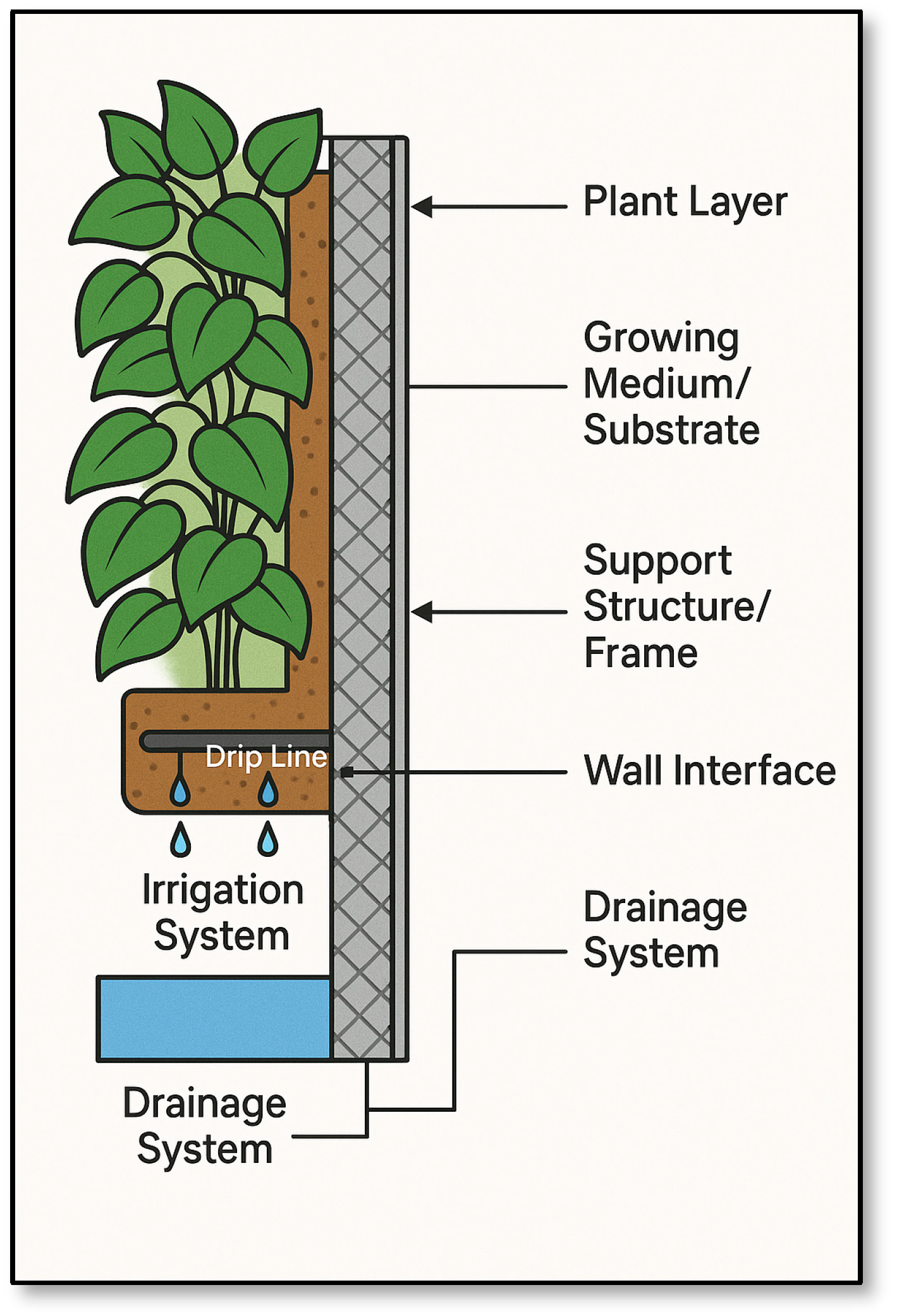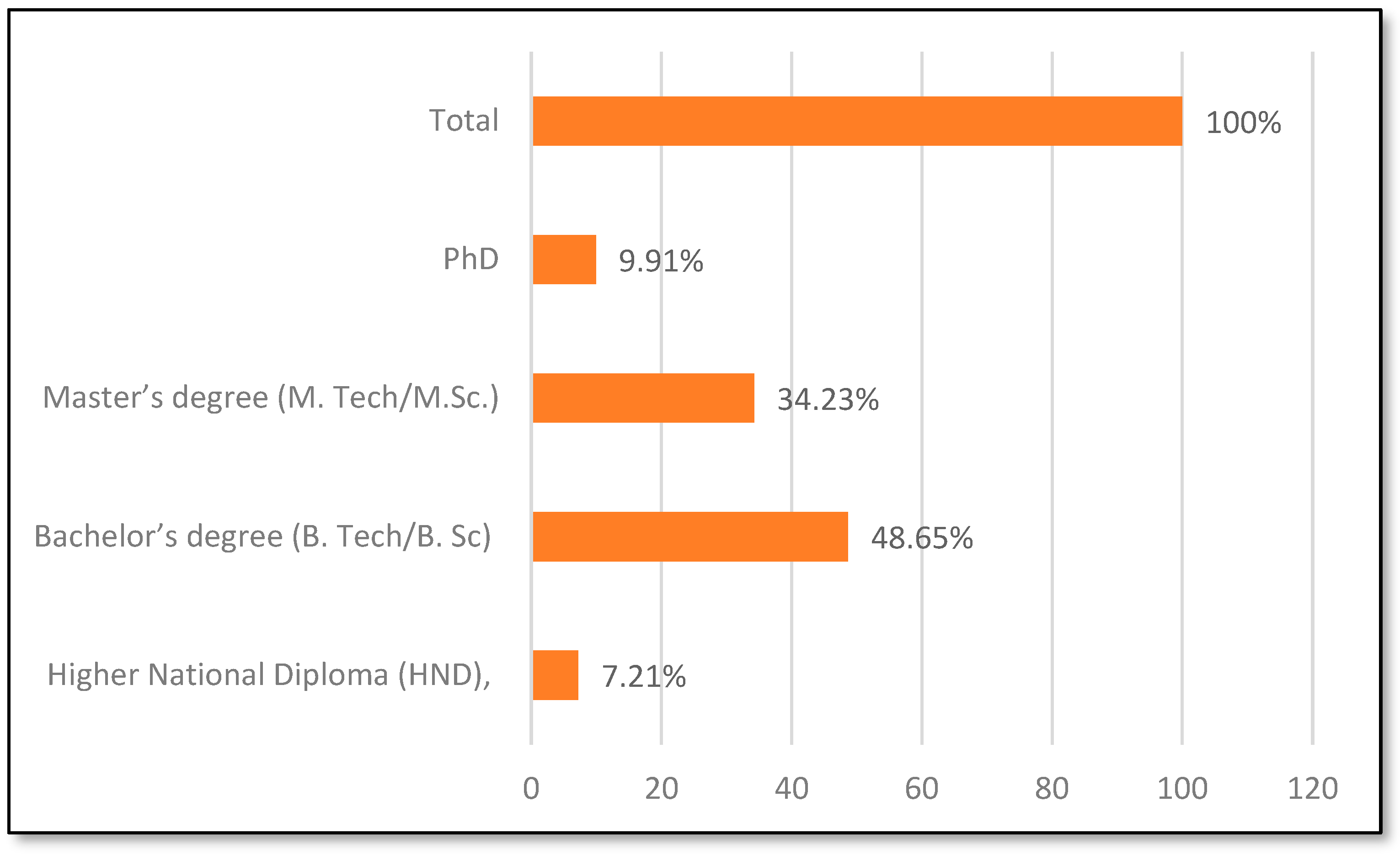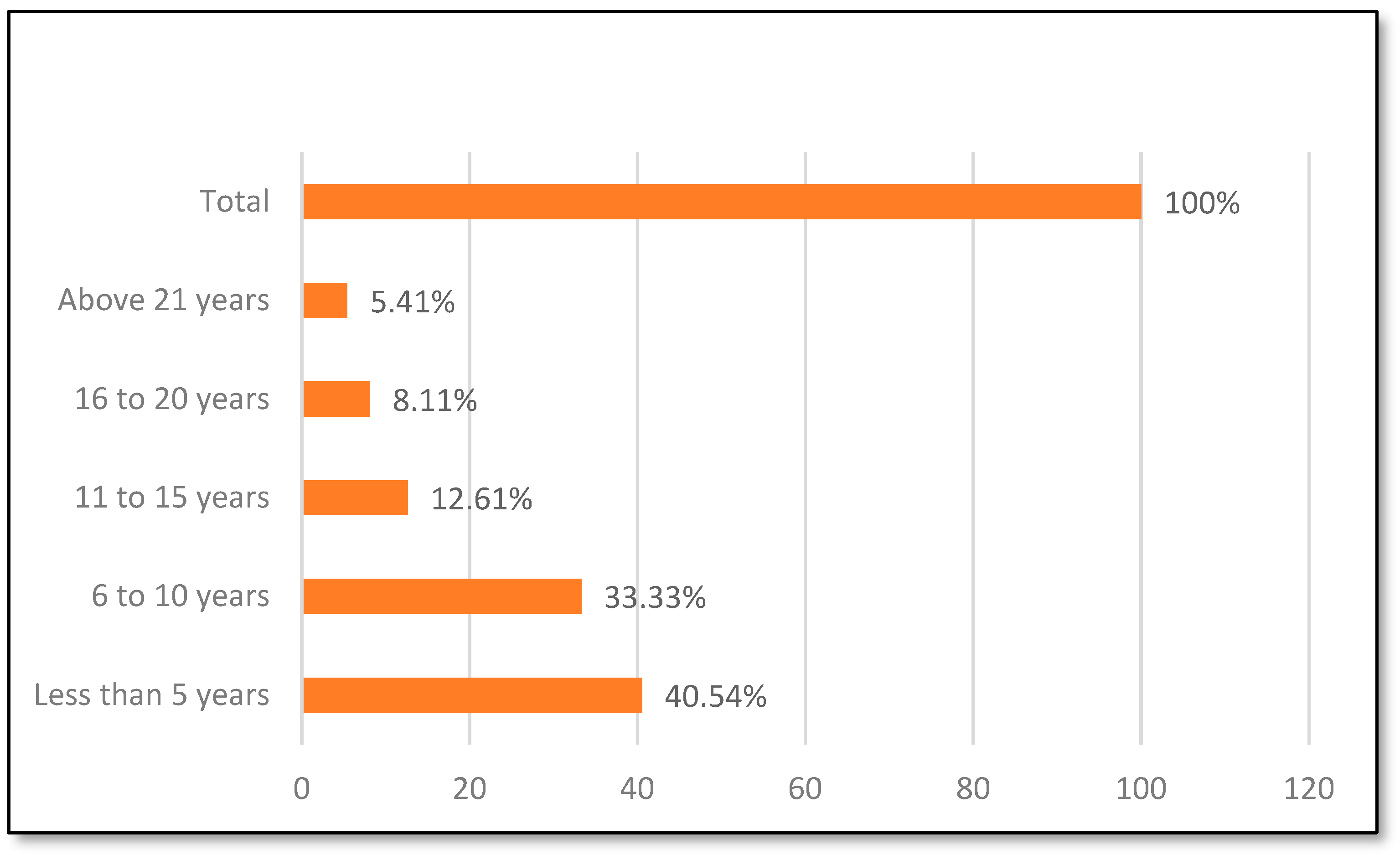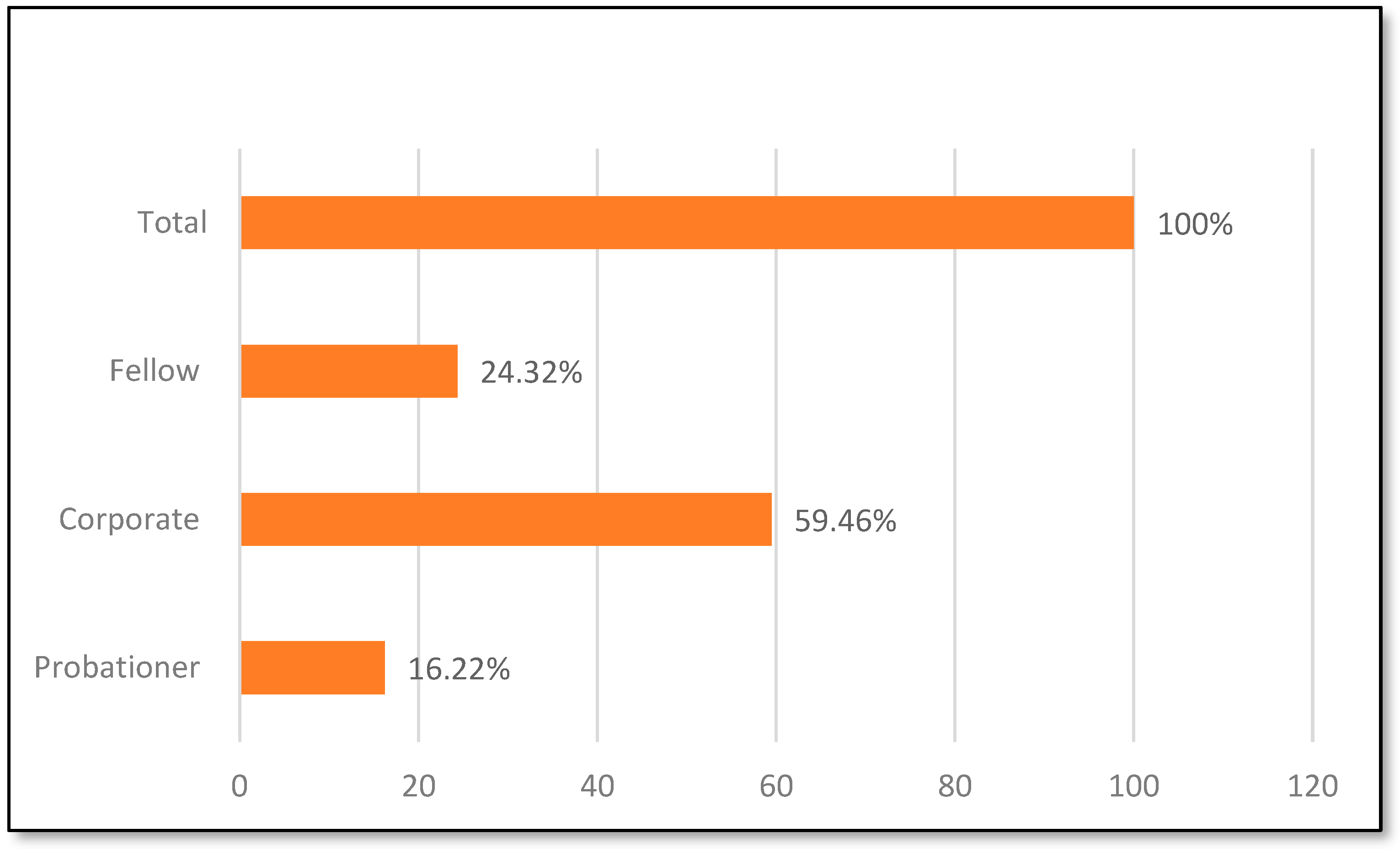Assessing the Adoption and Feasibility of Green Wall Systems in Construction Projects in Nigeria
Abstract
1. Introduction
- To what extent are construction professionals in Nigeria familiar with green wall application systems?
- To what extent are construction professionals actually integrating these green wall systems into construction activities?
- What strategies can be implemented to bridge the gap between awareness and practical adoption of green wall systems in the Nigerian construction industry?
2. Review of Existing Studies
2.1. Understanding the Concept of Green Wall Systems
2.2. Overview of Green Wall Systems in Construction
2.3. Limitations and Drawbacks of Green Wall Systems
3. Research Methodology
4. Results
4.1. Background Details of Respondents
4.2. Level of Awareness of Green Wall System Applications in the Construction Industry
4.3. Level of Practical Use of Green Wall System Applications in the Construction Industry
4.4. Mean Gap Analysis for Awareness and Usage
5. Discussions and Implications of the Above Findings
6. Conclusions and Areas for Future Research
Author Contributions
Funding
Institutional Review Board Statement
Informed Consent Statement
Data Availability Statement
Conflicts of Interest
References
- Manouchehri, M.; Santiago López, J.; Valiente López, M. Sustainable design of vertical greenery systems: A comprehensive framework. Sustainability 2024, 16, 3249. [Google Scholar] [CrossRef]
- El Menshawy, A.S.; Mohamed, A.F.; Fathy, N.M. A comparative study on green wall construction systems, case study: South valley campus of AASTMT. Case Stud. Constr. Mater. 2022, 16, e00808. [Google Scholar] [CrossRef]
- Ascione, F.; De Masi, R.F.; Mastellone, M.; Ruggiero, S.; Vanoli, G.P. Green walls, a critical review: Knowledge gaps, design parameters, thermal performances and multi-criteria design approaches. Energies 2020, 13, 2296. [Google Scholar] [CrossRef]
- Dong, X.; He, B.J. A standardized assessment framework for green roof decarbonization: A review of embodied carbon, carbon sequestration, bioenergy supply, and operational carbon scenarios. Renew. Sustain. Energy Rev. 2023, 182, 113376. [Google Scholar] [CrossRef]
- Freewan, A.A.; Jaradat, N.A.M.; Amaireh, I.A. Optimizing shading and thermal performances of vertical green wall on buildings in a hot arid region. Buildings 2022, 12, 216. [Google Scholar] [CrossRef]
- Vox, G.; Blanco, I.; Schettini, E. Green façades to control wall surface temperature in buildings. Build. Environ. 2018, 129, 154–166. [Google Scholar] [CrossRef]
- Calheiros, C.S.; Stefanakis, A.I. Green roofs towards circular and resilient cities. Circ. Econ. Sustain. 2021, 1, 395–411. [Google Scholar] [CrossRef] [PubMed]
- Ogut, O.; Tzortzi, N.J.; Bertolin, C. Vertical green structures to establish sustainable built environment: A systematic market review. Sustainability 2022, 14, 12349. [Google Scholar] [CrossRef]
- Ganiyu, A.Y.; Adebiyi, R.W.M.; Abdulraheem, R.T.; Orire, M.; Eluwa, I.S.; Stephen, E. Barrier Factors Affecting Adoption of Green Building Technologies in Nigeria. Built Environ. J. (BEJ) 2020, 17, 37–48. [Google Scholar] [CrossRef]
- Nzegbule, E.; Obiajunwa, U. Barriers and Enablers for Effective Adoption of Nature-Based Solutions (NbS) in Climate Change Mitigation and Adaptation in Nigeria. In Handbook of Nature-Based Solutions to Mitigation and Adaptation to Climate Change; Springer International Publishing: Cham, Switzerland, 2024. [Google Scholar]
- Jegede, F.O.; Adewale, B.A.; Ajonye, G.O.; Adebajo, T. Evaluation of the use of green façade in residential buildings in Kubwa, Abuja, Nigeria. In IOP Conference Series: Materials Science and Engineering; IOP Publishing: Bristol, UK, 2021. [Google Scholar]
- Ajibola, A.I.; Abiola, O.S.; Ruth, E.; Thomas, A.J.; George, O. Evaluation of sustainable climate-responsive façade in mixed-use high-rise development in Lagos, Nigeria: A study of Eko Atlantic City. Int. J. Multidiscip. Res. Growth Eval. 2024, 5, 336–341. [Google Scholar]
- Wang, W.; Zhou, X.; Wu, S.; Zhao, M.; Jin, Z.; Bei, K.; Zheng, X.; Fan, C. Vertical Green Wall Systems for Rainwater and Sewage Treatment. Sustainability 2024, 16, 7593. [Google Scholar] [CrossRef]
- Aung, T.; Liana, S.R.; Htet, A.; Bhaumik, A. Implementing green facades: A step towards sustainable smart buildings. J. Smart Cities Soc. 2023, 2, 41–51. [Google Scholar] [CrossRef]
- Unegbu, H.C.O.; Yawas, D.S.; Dan-asabe, B.; Alabi, A.A. Evaluating the Effectiveness of Green Roofs and Walls in Nigeria’s Urban Centers. Res. Sq. 2024, 1–29. [Google Scholar] [CrossRef]
- Radić, M.; Brković Dodig, M.; Auer, T. Green facades and living walls—A review establishing the classification of construction types and mapping the benefits. Sustainability 2019, 11, 4579. [Google Scholar] [CrossRef]
- Susca, T.; Zanghirella, F.; Colasuonno, L.; Del Fatto, V. Effect of green wall installation on urban heat island and building energy use: A climate-informed systematic literature review. Renew. Sustain. Energy Rev. 2022, 159, 112100. [Google Scholar] [CrossRef]
- Hasnan, M.T.I.M.T.; Yunus, J.; Radzun, K.A.; Zawawi, E.M.A.; Ramli, S.A. Unveiling the potential of green facade retrofit for commercial shopping malls in Kuala Lumpur, Malaysia. J. Des. Built Environ. 2024, 1–26. [Google Scholar] [CrossRef]
- Thomsit-Ireland, F. Overcoming the Barriers to Green Walls in Urban Areas of the UK; University of Reading: Reading, UK, 2019. [Google Scholar]
- Rout, S.; Khare, P.K. Climbing Strategies: A Key to Understanding Liana Ecology in Tropical Forests. J. Agric. Sci. Eng. Innov. (JASEI) 2024, 4, 40–49. [Google Scholar]
- Riley, B.; de Larrard, F.; Malécot, V.; Dubois-Brugger, I.; Lequay, H.; Lecomte, G. Living concrete: Democratizing living walls. Sci. Total Environ. 2019, 673, 281–295. [Google Scholar] [CrossRef] [PubMed]
- Azkorra, Z.; Pérez, G.; Coma, J.; Cabeza, L.F.; Burés, S.; Álvaro, J.E.; Erkoreka, A.; Urrestarazu, M. Evaluation of green walls as a passive acoustic insulation system for buildings. Appl. Acoust. 2015, 89, 46–56. [Google Scholar] [CrossRef]
- Abdo, P.; Huynh, B.P.; Irga, P.J.; Torpy, F.R. Evaluation of air flow through an active green wall biofilter. Urban For. Urban Green. 2019, 41, 75–84. [Google Scholar] [CrossRef]
- Aghimien, D.O.; Aliu, J.; Aigbavboa, C. Exploring blue-green roof for a sustainable built environment in South Africa. Smart Sustain. Built Environ. 2024. [Google Scholar] [CrossRef]
- Liu, F.; Yan, L.; Meng, X.; Zhang, C. A review on indoor green plants employed to improve indoor environment. J. Build. Eng. 2022, 53, 104542. [Google Scholar] [CrossRef]
- Mirrahimi, S.; Mohamed, M.F.; Haw, L.C.; Ibrahim, N.L.N.; Yusoff, W.F.M.; Aflaki, A. The effect of building envelope on the thermal comfort and energy saving for high-rise buildings in hot–humid climate. Renew. Sustain. Energy Rev. 2016, 53, 1508–1519. [Google Scholar] [CrossRef]
- Sadeghian, M.M. A review on green wall, classification and function. Int. J. Sci. Res. Sci. Technol. 2016, 2, 47–51. [Google Scholar]
- Moshood, A.W.B.; Orunbon, N.O. Politics of Identity and Democratic Consolidation in Nigeria: A Case Study of 2023 Presidential Election in Lagos State, Nigeria. Soc. Sci. Humanit. Educ. J. (SHE J.) 2024, 5, 197–210. [Google Scholar]
- Enoh, M.A.; Njoku, R.E.; Okeke, U.C. Modeling and mapping the spatial–temporal changes in land use and land cover in Lagos: A dynamics for building a sustainable urban city. Adv. Space Res. 2023, 72, 694–710. [Google Scholar] [CrossRef]
- Mehrad, A.; Zangeneh, M.H.T. Comparison between qualitative and quantitative research approaches: Social sciences. Int. J. Res. Educ. Stud. 2019, 5, 36–43. [Google Scholar]
- Keadkraichaiwat, I.; Sitticharoon, C.; Lertsiripatarajit, V.; Maprapho, P. Effects of using audience response systems (Kahoot and Google Forms and Sheets) on learning of medical students in a large class: A questionnaire-based retrospective study. Educ. Inf. Technol. 2024, 29, 17539–17563. [Google Scholar] [CrossRef]
- Haven, T.L.; Errington, T.M.; Gleditsch, K.S.; van Grootel, L.; Jacobs, A.M.; Kern, F.G.; Piñeiro, R.; Rosenblatt, F.; Mokkink, L.B. Preregistering qualitative research: A Delphi study. Int. J. Qual. Methods 2020, 19, 1609406920976417. [Google Scholar] [CrossRef]
- Pallant, J. SPSS Survival Manual: A Step by Step Guide to Data Analysis Using SPSS for Windows (Version 12); Allen & Unwin: Crows Nest, Australia, 2005. [Google Scholar]
- Nguyen, B.V.D.; Han, J.; Moere, A.V. Towards Responsive Architecture that Mediates Place: Recommendations on How and When an Autonomously Moving Robotic Wall Should Adapt a Spatial Layout. Proc. ACM Hum. Comput. Interact. 2022, 6, 1–27. [Google Scholar] [CrossRef]
- Hamid, H.N.A.; Romali, N.S.; Rahman, R.A. Key barriers and feasibility of implementing green roofs on buildings in Malaysia. Buildings 2023, 13, 2233. [Google Scholar] [CrossRef]
- Arowoiya, V.A.; Akinradewo, O.F.; Oke, A.E. Enhancing Competencies of Quantity Surveyors in Cost Management of Mechanical and Electrical Services. J. Surv. Constr. Prop. 2022, 13, 32–41. [Google Scholar] [CrossRef]
- Liberalesso, T.; Cruz, C.O.; Silva, C.M.; Manso, M. Green infrastructure and public policies: An international review of green roofs and green walls incentives. Land Use Policy 2020, 96, 104693. [Google Scholar] [CrossRef]
- Zhang, L. Analysis of energy saving effect of green building exterior wall structure based on ANSYS simulation analysis. Environ. Technol. Innov. 2021, 23, 101673. [Google Scholar] [CrossRef]
- Thomas, G.; Thomas, J.; Mathews, G.M.; Alexander, S.P.; Jose, J. Assessment of the potential of green wall on modification of local urban microclimate in humid tropical climate using ENVI-met model. Ecol. Eng. 2023, 187, 106868. [Google Scholar] [CrossRef]





| S/N | Green Wall System Applications | Literature Sources |
|---|---|---|
| 1 | Artistic green walls | [22] |
| 2 | Biodiverse green walls | [16] |
| 3 | Biofilteration green walls | [23] |
| 4 | Climbing plants vines | [20] |
| 5 | Edible green walls | [24] |
| 6 | External walls | [16] |
| 7 | Green curtain walls | [23] |
| 8 | Green façades | [14] |
| 9 | Green roofs | [24] |
| 10 | Green screens | [24] |
| 11 | Indoor wall plants | [25] |
| 12 | Integrated green system | [25] |
| 13 | Living walls | [24] |
| 14 | Modular green walls | [24] |
| 15 | Pocket gardens | [23] |
| 16 | Self-sustaining green walls | [25] |
| 17 | Superficial vegetation coverings | [23] |
| 18 | Vertical green system | [24] |
| Green Wall System Applications | Architects | Quantity Surveyors | Engineers | Builders | Project Managers | Overall | Kruskal–Wallis | |||||||
|---|---|---|---|---|---|---|---|---|---|---|---|---|---|---|
| Mean | Rank | Mean | Rank | Mean | Rank | Mean | Rank | Mean | Rank | Mean | Rank | χ2 | Sig. | |
| External walls | 4.24 | 1 | 3.86 | 1 | 3.74 | 1 | 4.13 | 1 | 4.33 | 1 | 3.97 | 1 | 2.731 | 0.582 |
| Green roofs | 3.29 | 6 | 3.56 | 2 | 3.65 | 2 | 3.77 | 6 | 3.67 | 12 | 3.59 | 2 | 6.112 | 0.137 |
| Indoor wall plants | 3.35 | 3 | 3.47 | 3 | 3.48 | 6 | 3.61 | 10 | 4.00 | 7 | 3.50 | 3 | 8.961 | 0.167 |
| Green façades | 3.47 | 2 | 3.44 | 4 | 3.17 | 15 | 3.84 | 5 | 3.67 | 9 | 3.49 | 4 | 14.225 | 0.096 |
| Climbing plants vines | 3.29 | 4 | 3.11 | 8 | 3.26 | 11 | 4.06 | 2 | 3.00 | 17 | 3.42 | 5 | 13.856 | 0.112 |
| Superficial vegetation coverings | 3.00 | 12 | 3.25 | 5 | 3.57 | 3 | 3.65 | 9 | 3.67 | 11 | 3.40 | 6 | 10.431 | 0.135 |
| Living walls | 2.94 | 13 | 3.14 | 7 | 3.48 | 5 | 3.74 | 7 | 4.00 | 2 | 3.36 | 7 | 9.218 | 0.148 |
| Green curtain walls | 3.00 | 11 | 2.94 | 12 | 3.35 | 8 | 3.94 | 3 | 3.33 | 15 | 3.31 | 8 | 8.452 | 0.085 |
| Artistic green walls | 3.12 | 9 | 3.19 | 6 | 3.17 | 13 | 3.65 | 8 | 4.00 | 3 | 3.31 | 9 | 5.472 | 0.256 |
| Integrated green system | 2.82 | 16 | 3.00 | 9 | 3.17 | 14 | 3.90 | 4 | 3.33 | 13 | 3.26 | 10 | 3.985 | 0.417 |
| Vertical green system | 3.12 | 8 | 3.00 | 11 | 3.26 | 11 | 3.55 | 11 | 4.00 | 6 | 3.23 | 11 | 4.915 | 0.328 |
| Green screens | 3.29 | 5 | 3.00 | 10 | 3.39 | 7 | 3.39 | 15 | 3.67 | 8 | 3.23 | 12 | 5.254 | 0.295 |
| Pocket gardens | 3.24 | 7 | 2.78 | 15 | 3.30 | 10 | 3.55 | 12 | 3.33 | 16 | 3.18 | 13 | 6.722 | 0.138 |
| Self-sustaining green walls | 2.94 | 14 | 2.89 | 13 | 3.30 | 9 | 3.42 | 14 | 4.00 | 4 | 3.16 | 14 | 4.310 | 0.366 |
| Modular green walls | 3.06 | 10 | 2.81 | 14 | 3.22 | 12 | 3.19 | 18 | 4.00 | 5 | 3.05 | 15 | 1.245 | 0.911 |
| Edible green walls | 2.71 | 18 | 2.72 | 16 | 3.52 | 4 | 3.29 | 17 | 3.67 | 10 | 3.05 | 16 | 6.523 | 0.195 |
| Biodiverse green walls | 2.88 | 15 | 2.69 | 18 | 3.13 | 18 | 3.32 | 16 | 3.33 | 14 | 3.00 | 17 | 7.349 | 0.095 |
| Biofilteration green walls | 2.76 | 17 | 2.69 | 17 | 3.13 | 17 | 3.45 | 13 | 3.00 | 18 | 3.00 | 18 | 6.199 | 0.162 |
| Green Wall System Applications | Level of Awareness | Level of Practical Use | Mean Gap (Awareness—Usage) | ||
|---|---|---|---|---|---|
| Mean | Rank | Mean | Rank | (Mean Gap) | |
| External walls | 3.97 | 1 | 3.54 | 1 | 0.43 |
| Green roofs | 3.59 | 2 | 3.21 | 2 | 0.38 |
| Indoor wall plants | 3.50 | 3 | 3.03 | 6 | 0.47 |
| Green façades | 3.49 | 4 | 3.06 | 5 | 0.43 |
| Climbing plants vines | 3.42 | 5 | 3.11 | 3 | 0.31 |
| Superficial vegetation coverings | 3.40 | 6 | 3.06 | 4 | 0.34 |
| Living walls | 3.36 | 7 | 3.02 | 7 | 0.34 |
| Green curtain walls | 3.31 | 8 | 2.97 | 9 | 0.34 |
| Artistic green walls | 3.31 | 9 | 2.96 | 10 | 0.35 |
| Integrated green system | 3.26 | 10 | 2.96 | 11 | 0.30 |
| Vertical green system | 3.23 | 11 | 3.01 | 8 | 0.22 |
| Green screens | 3.23 | 12 | 2.82 | 14 | 0.41 |
| Pocket gardens | 3.18 | 13 | 2.94 | 12 | 0.24 |
| Self-sustaining green walls | 3.16 | 14 | 2.84 | 13 | 0.32 |
| Modular green walls | 3.05 | 15 | 2.76 | 17 | 0.29 |
| Edible green walls | 3.05 | 16 | 2.80 | 15 | 0.25 |
| Biodiverse green walls | 3.00 | 17 | 2.79 | 16 | 0.21 |
| Biofilteration green walls | 3.00 | 18 | 2.70 | 18 | 0.30 |
| Green Wall System Applications | Architects | Quantity Surveyors | Engineers | Builders | Project Managers | Overall | Kruskal–Wallis | |||||||
|---|---|---|---|---|---|---|---|---|---|---|---|---|---|---|
| Mean | Rank | Mean | Rank | Mean | Rank | Mean | Rank | Mean | Rank | Mean | Rank | χ2 | Sig. | |
| External walls | 3.82 | 1 | 3.14 | 1 | 3.74 | 1 | 3.68 | 1 | 4.33 | 1 | 3.54 | 1 | 2.845 | 0.573 |
| Green roofs | 3.12 | 2 | 2.89 | 2 | 3.61 | 2 | 3.32 | 6 | 3.33 | 16 | 3.21 | 2 | 5.978 | 0.142 |
| Climbing plants vines | 2.76 | 9 | 2.78 | 5 | 3.35 | 3 | 3.45 | 2 | 4.00 | 4 | 3.11 | 3 | 8.732 | 0.172 |
| Superficial vegetation coverings | 3.00 | 5 | 2.81 | 4 | 3.35 | 4 | 3.23 | 10 | 3.00 | 18 | 3.06 | 4 | 14.552 | 0.101 |
| Green façades | 3.00 | 6 | 2.83 | 3 | 3.22 | 14 | 3.19 | 11 | 4.00 | 5 | 3.06 | 5 | 13.487 | 0.118 |
| Indoor wall plants | 3.06 | 4 | 2.69 | 6 | 3.22 | 15 | 3.23 | 9 | 3.67 | 9 | 3.03 | 6 | 10.215 | 0.128 |
| Living walls | 2.71 | 11 | 2.64 | 7 | 3.30 | 6 | 3.35 | 5 | 4.00 | 2 | 3.02 | 7 | 9.067 | 0.153 |
| Vertical green system | 3.06 | 3 | 2.58 | 9 | 3.30 | 8 | 3.26 | 7 | 3.33 | 15 | 3.01 | 8 | 8.627 | 0.089 |
| Green curtain walls | 2.71 | 12 | 2.58 | 8 | 3.26 | 10 | 3.35 | 4 | 3.33 | 11 | 2.97 | 9 | 5.319 | 0.248 |
| Arstistic green walls | 2.88 | 7 | 2.56 | 10 | 3.26 | 9 | 3.26 | 8 | 3.33 | 10 | 2.96 | 10 | 4.102 | 0.426 |
| Integrated green system | 2.59 | 14 | 2.53 | 11 | 3.22 | 16 | 3.42 | 3 | 4.00 | 3 | 2.96 | 11 | 4.832 | 0.321 |
| Pocket gardens | 2.82 | 8 | 2.50 | 13 | 3.35 | 5 | 3.19 | 12 | 3.33 | 12 | 2.94 | 12 | 5.367 | 0.287 |
| Self-sustaining green walls | 2.59 | 15 | 2.44 | 14 | 3.17 | 17 | 3.13 | 13 | 3.67 | 7 | 2.84 | 13 | 6.815 | 0.141 |
| Green screens | 2.53 | 17 | 2.50 | 12 | 3.22 | 13 | 3.03 | 16 | 3.33 | 13 | 2.82 | 14 | 4.225 | 0.359 |
| Edible green walls | 2.41 | 18 | 2.39 | 16 | 3.30 | 7 | 3.03 | 15 | 4.00 | 6 | 2.80 | 15 | 1.312 | 0.924 |
| Biodiverse green walls | 2.71 | 10 | 2.28 | 18 | 3.22 | 12 | 3.06 | 14 | 3.67 | 8 | 2.79 | 16 | 6.488 | 0.188 |
| Modular green walls | 2.53 | 16 | 2.39 | 15 | 3.26 | 11 | 2.90 | 17 | 3.33 | 14 | 2.76 | 17 | 7.521 | 0.099 |
| Biofiltration walls | 2.65 | 13 | 2.31 | 17 | 3.09 | 17 | 2.90 | 18 | 3.00 | 17 | 2.70 | 18 | 6.084 | 0.157 |
Disclaimer/Publisher’s Note: The statements, opinions and data contained in all publications are solely those of the individual author(s) and contributor(s) and not of MDPI and/or the editor(s). MDPI and/or the editor(s) disclaim responsibility for any injury to people or property resulting from any ideas, methods, instructions or products referred to in the content. |
© 2025 by the authors. Licensee MDPI, Basel, Switzerland. This article is an open access article distributed under the terms and conditions of the Creative Commons Attribution (CC BY) license (https://creativecommons.org/licenses/by/4.0/).
Share and Cite
Oke, O.S.; Aliu, J.O.; Ekundayo, D.; Oke, A.E.; Chukwuma, N.K. Assessing the Adoption and Feasibility of Green Wall Systems in Construction Projects in Nigeria. Sustainability 2025, 17, 7126. https://doi.org/10.3390/su17157126
Oke OS, Aliu JO, Ekundayo D, Oke AE, Chukwuma NK. Assessing the Adoption and Feasibility of Green Wall Systems in Construction Projects in Nigeria. Sustainability. 2025; 17(15):7126. https://doi.org/10.3390/su17157126
Chicago/Turabian StyleOke, Oluwayinka Seun, John Ogbeleakhu Aliu, Damilola Ekundayo, Ayodeji Emmanuel Oke, and Nwabueze Kingsley Chukwuma. 2025. "Assessing the Adoption and Feasibility of Green Wall Systems in Construction Projects in Nigeria" Sustainability 17, no. 15: 7126. https://doi.org/10.3390/su17157126
APA StyleOke, O. S., Aliu, J. O., Ekundayo, D., Oke, A. E., & Chukwuma, N. K. (2025). Assessing the Adoption and Feasibility of Green Wall Systems in Construction Projects in Nigeria. Sustainability, 17(15), 7126. https://doi.org/10.3390/su17157126








